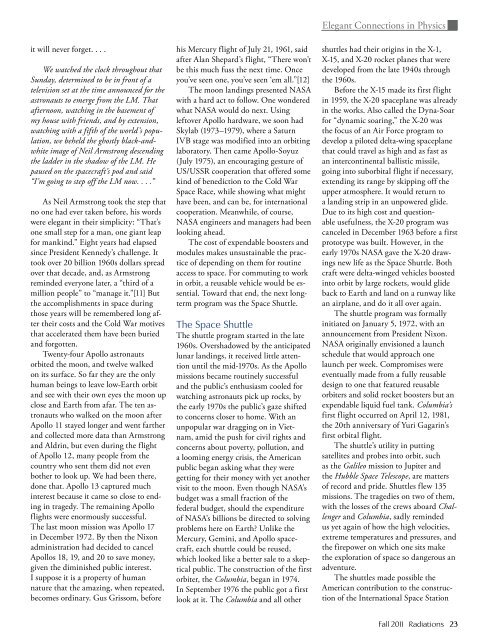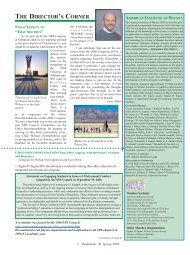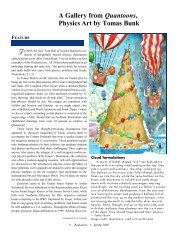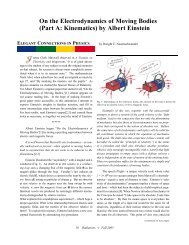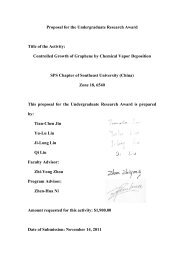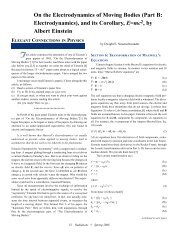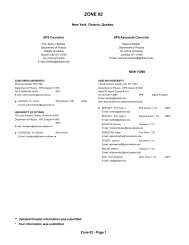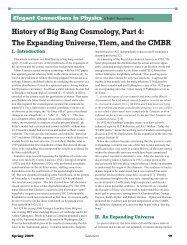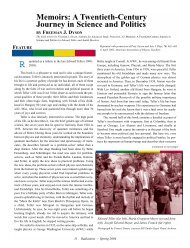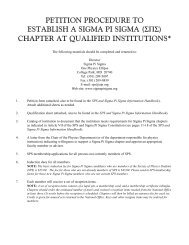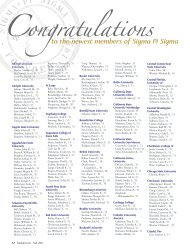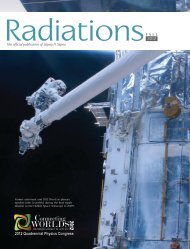Download a PDF of the entire issue - Sigma Pi Sigma
Download a PDF of the entire issue - Sigma Pi Sigma
Download a PDF of the entire issue - Sigma Pi Sigma
Create successful ePaper yourself
Turn your PDF publications into a flip-book with our unique Google optimized e-Paper software.
Elegant Connections in Physics<br />
it will never forget. . . .<br />
We watched <strong>the</strong> clock throughout that<br />
Sunday, determined to be in front <strong>of</strong> a<br />
television set at <strong>the</strong> time announced for <strong>the</strong><br />
astronauts to emerge from <strong>the</strong> LM. That<br />
afternoon, watching in <strong>the</strong> basement <strong>of</strong><br />
my house with friends, and by extension,<br />
watching with a fifth <strong>of</strong> <strong>the</strong> world’s population,<br />
we beheld <strong>the</strong> ghostly black-andwhite<br />
image <strong>of</strong> Neil Armstrong descending<br />
<strong>the</strong> ladder in <strong>the</strong> shadow <strong>of</strong> <strong>the</strong> LM. He<br />
paused on <strong>the</strong> spacecraft’s pod and said<br />
“I’m going to step <strong>of</strong>f <strong>the</strong> LM now. . . .”<br />
As Neil Armstrong took <strong>the</strong> step that<br />
no one had ever taken before, his words<br />
were elegant in <strong>the</strong>ir simplicity: “That’s<br />
one small step for a man, one giant leap<br />
for mankind.” Eight years had elapsed<br />
since President Kennedy’s challenge. It<br />
took over 20 billion 1960s dollars spread<br />
over that decade, and, as Armstrong<br />
reminded everyone later, a “third <strong>of</strong> a<br />
million people” to “manage it.”[11] But<br />
<strong>the</strong> accomplishments in space during<br />
those years will be remembered long after<br />
<strong>the</strong>ir costs and <strong>the</strong> Cold War motives<br />
that accelerated <strong>the</strong>m have been buried<br />
and forgotten.<br />
Twenty-four Apollo astronauts<br />
orbited <strong>the</strong> moon, and twelve walked<br />
on its surface. So far <strong>the</strong>y are <strong>the</strong> only<br />
human beings to leave low-Earth orbit<br />
and see with <strong>the</strong>ir own eyes <strong>the</strong> moon up<br />
close and Earth from afar. The ten astronauts<br />
who walked on <strong>the</strong> moon after<br />
Apollo 11 stayed longer and went far<strong>the</strong>r<br />
and collected more data than Armstrong<br />
and Aldrin, but even during <strong>the</strong> flight<br />
<strong>of</strong> Apollo 12, many people from <strong>the</strong><br />
country who sent <strong>the</strong>m did not even<br />
bo<strong>the</strong>r to look up. We had been <strong>the</strong>re,<br />
done that. Apollo 13 captured much<br />
interest because it came so close to ending<br />
in tragedy. The remaining Apollo<br />
flights were enormously successful.<br />
The last moon mission was Apollo 17<br />
in December 1972. By <strong>the</strong>n <strong>the</strong> Nixon<br />
administration had decided to cancel<br />
Apollos 18, 19, and 20 to save money,<br />
given <strong>the</strong> diminished public interest.<br />
I suppose it is a property <strong>of</strong> human<br />
nature that <strong>the</strong> amazing, when repeated,<br />
becomes ordinary. Gus Grissom, before<br />
his Mercury flight <strong>of</strong> July 21, 1961, said<br />
after Alan Shepard’s flight, “There won’t<br />
be this much fuss <strong>the</strong> next time. Once<br />
you’ve seen one, you’ve seen ‘em all.”[12]<br />
The moon landings presented NASA<br />
with a hard act to follow. One wondered<br />
what NASA would do next. Using<br />
leftover Apollo hardware, we soon had<br />
Skylab (1973–1979), where a Saturn<br />
IVB stage was modified into an orbiting<br />
laboratory. Then came Apollo-Soyuz<br />
(July 1975), an encouraging gesture <strong>of</strong><br />
US/USSR cooperation that <strong>of</strong>fered some<br />
kind <strong>of</strong> benediction to <strong>the</strong> Cold War<br />
Space Race, while showing what might<br />
have been, and can be, for international<br />
cooperation. Meanwhile, <strong>of</strong> course,<br />
NASA engineers and managers had been<br />
looking ahead.<br />
The cost <strong>of</strong> expendable boosters and<br />
modules makes unsustainable <strong>the</strong> practice<br />
<strong>of</strong> depending on <strong>the</strong>m for routine<br />
access to space. For commuting to work<br />
in orbit, a reusable vehicle would be essential.<br />
Toward that end, <strong>the</strong> next longterm<br />
program was <strong>the</strong> Space Shuttle.<br />
The Space Shuttle<br />
The shuttle program started in <strong>the</strong> late<br />
1960s. Overshadowed by <strong>the</strong> anticipated<br />
lunar landings, it received little attention<br />
until <strong>the</strong> mid-1970s. As <strong>the</strong> Apollo<br />
missions became routinely successful<br />
and <strong>the</strong> public’s enthusiasm cooled for<br />
watching astronauts pick up rocks, by<br />
<strong>the</strong> early 1970s <strong>the</strong> public’s gaze shifted<br />
to concerns closer to home. With an<br />
unpopular war dragging on in Vietnam,<br />
amid <strong>the</strong> push for civil rights and<br />
concerns about poverty, pollution, and<br />
a looming energy crisis, <strong>the</strong> American<br />
public began asking what <strong>the</strong>y were<br />
getting for <strong>the</strong>ir money with yet ano<strong>the</strong>r<br />
visit to <strong>the</strong> moon. Even though NASA’s<br />
budget was a small fraction <strong>of</strong> <strong>the</strong><br />
federal budget, should <strong>the</strong> expenditure<br />
<strong>of</strong> NASA’s billions be directed to solving<br />
problems here on Earth? Unlike <strong>the</strong><br />
Mercury, Gemini, and Apollo spacecraft,<br />
each shuttle could be reused,<br />
which looked like a better sale to a skeptical<br />
public. The construction <strong>of</strong> <strong>the</strong> first<br />
orbiter, <strong>the</strong> Columbia, began in 1974.<br />
In September 1976 <strong>the</strong> public got a first<br />
look at it. The Columbia and all o<strong>the</strong>r<br />
shuttles had <strong>the</strong>ir origins in <strong>the</strong> X-1,<br />
X-15, and X-20 rocket planes that were<br />
developed from <strong>the</strong> late 1940s through<br />
<strong>the</strong> 1960s.<br />
Before <strong>the</strong> X-15 made its first flight<br />
in 1959, <strong>the</strong> X-20 spaceplane was already<br />
in <strong>the</strong> works. Also called <strong>the</strong> Dyna-Soar<br />
for “dynamic soaring,” <strong>the</strong> X-20 was<br />
<strong>the</strong> focus <strong>of</strong> an Air Force program to<br />
develop a piloted delta-wing spaceplane<br />
that could travel as high and as fast as<br />
an intercontinental ballistic missile,<br />
going into suborbital flight if necessary,<br />
extending its range by skipping <strong>of</strong>f <strong>the</strong><br />
upper atmosphere. It would return to<br />
a landing strip in an unpowered glide.<br />
Due to its high cost and questionable<br />
usefulness, <strong>the</strong> X-20 program was<br />
canceled in December 1963 before a first<br />
prototype was built. However, in <strong>the</strong><br />
early 1970s NASA gave <strong>the</strong> X-20 drawings<br />
new life as <strong>the</strong> Space Shuttle. Both<br />
craft were delta-winged vehicles boosted<br />
into orbit by large rockets, would glide<br />
back to Earth and land on a runway like<br />
an airplane, and do it all over again.<br />
The shuttle program was formally<br />
initiated on January 5, 1972, with an<br />
announcement from President Nixon.<br />
NASA originally envisioned a launch<br />
schedule that would approach one<br />
launch per week. Compromises were<br />
eventually made from a fully reusable<br />
design to one that featured reusable<br />
orbiters and solid rocket boosters but an<br />
expendable liquid fuel tank. Columbia’s<br />
first flight occurred on April 12, 1981,<br />
<strong>the</strong> 20th anniversary <strong>of</strong> Yuri Gagarin’s<br />
first orbital flight.<br />
The shuttle’s utility in putting<br />
satellites and probes into orbit, such<br />
as <strong>the</strong> Galileo mission to Jupiter and<br />
<strong>the</strong> Hubble Space Telescope, are matters<br />
<strong>of</strong> record and pride. Shuttles flew 135<br />
missions. The tragedies on two <strong>of</strong> <strong>the</strong>m,<br />
with <strong>the</strong> losses <strong>of</strong> <strong>the</strong> crews aboard Challenger<br />
and Columbia, sadly reminded<br />
us yet again <strong>of</strong> how <strong>the</strong> high velocities,<br />
extreme temperatures and pressures, and<br />
<strong>the</strong> firepower on which one sits make<br />
<strong>the</strong> exploration <strong>of</strong> space so dangerous an<br />
adventure.<br />
The shuttles made possible <strong>the</strong><br />
American contribution to <strong>the</strong> construction<br />
<strong>of</strong> <strong>the</strong> International Space Station<br />
Fall 2011 Radiations 23


